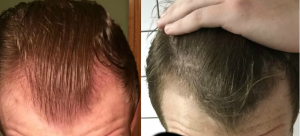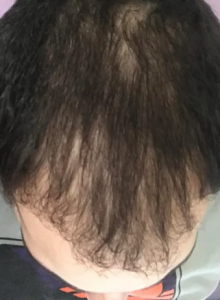As men get older, their testosterone often drops along with the DHT levels in their blood. That is why balding reduces. Actually, when DHT levels are the highest in your teens and early 20s, the impact of the DHT on genetic balding is highest also?. For women it works in the reverse because the high estrogen levels of fertile females, counter balances any androgen (testosterone is an androgen) her body produces and genetic balding it put at bay.
The important take-away here is that within 4 days, with proper washing techniques, there is no scabbing present and nothing detectable short of a little tinge of pinkish color if you look close. All patients having a hair transplant should look like this within 4 days of the transplant. Some of the hairs that were placed already have shed so you can see why it is impossible to count the grafts after a few days.

Few, if any of our baldingblog readers, may know the name, but this is the man who was the ‘inventor’ of modern hair transplantation in the 1950s. What he taught us, was the hairy skin taken from the back and side of the head, when placed in a bald area, would grow the hair and not be impacted by the balding. He called that ‘Donor Dominance’ and the rest is history. It took almost a decade for the journals, the dermatologists of the time and the medical establishment to accept his pioneering discovery, but because of his discovery, we have possibly a $10 Billion hair transplant business world-wide today that helps hundreds of thousands of people. Read about him in the New York Times here: https://www.nytimes.com/2019/02/21/business/dr-norman-orentreich-dead.html?fbclid=IwAR00A3NAeWyZsU-cLcT288mVH_0dG8u6H-qmpyxDss7fpfG-lEy_8lUmrvY
Scalp reduction is the answer to your question. This is when there is a bald area in the back of the top of the head, and the surgeon removes the bald area and leaves a large scar running down the excision area. This is a permanent scar, and the bald area’s removal usually returns or worsens too quickly and makes the person more bald. Most of the time, in those days, the surgeon chased the recurrent balding with more and more Scalp Reductions. I know from personal experience because I had three of them done on my head, which left me scarred and with a paper-thin scalp that used to bleed regularly. I then figured out that if I transplanted it, the transplants would restore the infrastructure to the scarred area. I was lucky because I only had crown balding and a lot of donor hair. Still, I suspect that Donald Trump was not so lucky and ended up chasing his hair loss with the old type of plugs, leaving his donor area heavily depleted, as seen in this video.
I always ask my patients if they needed brain or heart surgery, would they try to find the least expensive doctor and hospital. Although hair transplants usually won’t kill you (although there have been deaths reported but they are rare in the US, Europe and Asia), what you get on your head from a hair transplant will (1) be there for everyone to see, (2) impact your donor supply so if the transplant is not part of a Master Plan, then a single hair transplant impact will be short term and there may be long term consequences of (a) depleting the donor supply, (b) continued balding which is 100% for men, and (3) growth, to be good, reflects the experience of the surgeon and his/her team. You may not get this with the least expensive option. The problem with many of the Turkey clinics, is that over 90% of them are illegal clinics and we never hear about deaths from anesthesia (because it would be bad for business) but we do see many complications in the US and Europe from many of these bad clinics.
Post Finasteride Syndrome is very uncommon. In my practice of 27 years, I have prescribed this drug on tens of thousands of men, although I did hear reports of sexual side effects in between 2-4% of these patients, I have never had a single case of PFS discussed with me. I have very good relationships with my patients and I am absolutely sure that if their sexual side effects would have persisted, I would have been part of the solution for these patients and been involved in their management of the problem.
Both Caffeine and Minoxidil when applied to the scalp, can induce hair growth. In a recent study in a peer reviewed journal, both 2% caffeine and the 5% minoxidil were both equal in value when applied to the scalp topically.?
I always talk about a “tug of war” between finasteride and genetic balding. Sometimes the finasteride wins, other times it is overwhelmed by the genetic balding process. This is why you need a doctor to help you develop a Master Plan to determine the next steps that you need to take when you are losing the Tug of War.
From the tens of thousands of patients I have prescribed this drug to, I have never heard such a complaint.
I have been on finasteride for over 2 years with good results, but I’ve been dealing with pretty bad sleep/energy/anxiety issues the last ~18 months. (No sexual sides, though.)
I’ve made a lot of lifestyle changes to try to address those issues, but nothing’s really worked. I’m beginning to wonder if the issues are finasteride-related.
I’m thinking about cutting down from 1mg/day to 0.5mg per day for a month or two. Depending on how that goes, I might stay there or continue tapering off.
Is there any general advice regarding lowering/tapering off finasteride dosage?
Reducing your finasteride to half the dose may not have an impact on your hair; however, the more you cut, the greater your risk of losing the hairs you retained. If that happens, you might not get it back. I have seen many patients stop the drug for a couple of months and then lose ground so bad that they never get back to where they were before stopping it. Reducing the dose to every other day or every third day still keeps the drug effective above 50% of the full dose, so this is a reasonable approach if you think that your symptoms are drug-related.
This is the classic nocebo effect. However, finasteride does reduce DHT which is the boner hormone, so don’t be too surprised if your dong isn’t 100%. This effect is real as it can impact the physiology of the body, showing you how powerful the mind actually is.
If you are over 26, you might be a reasonable candidate for a hair transplant. Why 26? Because the patterns of balding become more evident at the age of 26, but the risk or more balding make it difficult, at times, to plan appropriately. If you use up your donor hair as many men do, then you are left deformed when the balding patterns finalize.
Modern day hair restoration procedures usually provide very satisfying results when performed by reputable accredited hair transplant surgeons. Major skin related permanent side effects or severe health problems during and after a hair transplant procedure is becoming a rarity.
However, even the best surgeons out there will have some bad results due to unforeseen circumstances or, in rare cases, the surgeon or assisting technician having a bad day. Nevertheless, this risk is much smaller in countries such as the US where official accreditation is indicative of at least a minimum level of competency.
On the other hand, if you get a hair transplant abroad in order to save money, you will need be very careful in selecting your surgeon. You want to make sure the surgeon is accredited by the non-profit ISHRS, is locally board certified, has decent online reviews, and allows you to meet a few of his or her past patients.
Earlier today, this issue was brought forward front and center into my mind after Pakistan based actor Sajid Hasan posted a graphic video online about his botched hair transplant gone wrong. It seems like the person who did this procedure several weeks ago might have been a medical doctor or general surgeon, and not even an official hair transplant surgeon.
Besides having persistent health-related side effects, Mr. Hasan’s scalp currently looks like something that was worked upon by a butcher.
In the 27 years I have been doing hair transplants with as many a 7 doctors working for me, we have performed over 16,000 surgeries and never saw a case like Mr. Hasan’s. I have, however, seen many cases of necrosis which came to me after the hair transplants were done. I have, with associates, perform balloon expander surgeries on these patients to address the area of necrosis. If these areas of necrosis were not large, they often can be treated with wound care and then transplanted with proper techniques. Mr. Hasan does not have to live with this deformity.
Page 292 of 635





